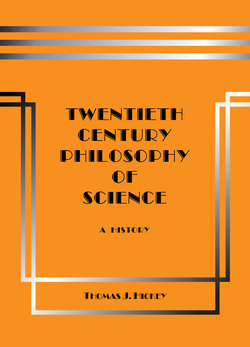Читать книгу Twentieth-Century Philosophy of Science: A History (Third Edition) - Thomas J. Hickey - Страница 105
На сайте Литреса книга снята с продажи.
4.25 Cognition Constraint
ОглавлениеThe semantics of every descriptive term is determined by its linguistic context consisting of universally quantified statements believed to be true.
Conversely given the conventionalized meaning for a descriptive term, certain beliefs determining the meaning of the term are reinforced by habitual linguistic fluency with the result that the meaning’s conventionality constrains change in those defining beliefs.
The conventionalized meanings for descriptive terms thus produce the cognition constraint, which inhibits construction of new theories, and is manifested as lack of imagination, creativity or ingenuity.
In his Course in General Linguistics (1916) Ferdinand de Saussure, the founder of semiology, maintained that spoken language is an institution, and that of all social institutions it is the least amenable to initiative. He called one of the several sources of resistance to linguistic change the “collective inertia toward innovation”.
In his Concept of the Positron (1963) Hanson similarly identified this impediment to discovery and called it the “conceptual constraint”. He reports that physicists’ erroneous identification of the concept of the particle with the concept of its charge was an impediment to recognizing the positron. The electron was identified with a negative charge and the much more massive proton was identified with a positive charge, so that the positron as a particle with the mass of an electron and a positive charge was not recognized without difficulty and delay.
In his Introduction to Metascience (1976) Hickey referred to what he called the “cognition constraint”. The cognition constraint inhibits construction of new theories, and is manifested as lack of imagination, creativity or ingenuity. Semantical rules are not just rules. They are also strong linguistic habits with subconscious roots that enable prereflective competence and fluency in both thought and speech, and that make meaning a synthetic psychological experience. Given a conventionalized belief or firm conviction expressible as a universally quantified affirmative statement, the predicate in that affirmation contributes meaning part(s) to the meaning complex of the statement’s subject term. Not only does the conventionalized status of meanings make development of new theories difficult, but also any new theory construction requires greater or lesser semantical dissolution and restructuring.
The cognition-constraint thesis is opposed to the neutral-language thesis that language is merely a passive instrument for expressing thought. Language is not merely passive but rather has a formative influence on thought. The formative influence of language as the “shaper of meaning” has been recognized as the Sapir-Whorf hypothesis and specifically by Benjamin Lee Whorf’s principle of linguistic relativity set forth in his “Science and Linguistics” (1940) reprinted in Language, Thought and Reality. But contrary to Whorf it is not just the grammatical system that determines semantics, but what Quine called the “web of belief”, the shared belief system as found in a dictionary.
Accordingly the more revolutionary the revision of beliefs, the more constraining are both the semantical structure and psychological conditioning on the creativity of the scientist who would develop a new theory, because revolutionary theory development requires relatively more extensive semantical dissolution and restructuring. However, use of computerized discovery systems circumvents the cognition constraint, because the machines have no linguistic-psychological habits. Their mindless electronic execution of mechanized procedures is one of their virtues.
Readers wishing to know more about the linguistic theory of Whorf are referred to BOOK VI below.
